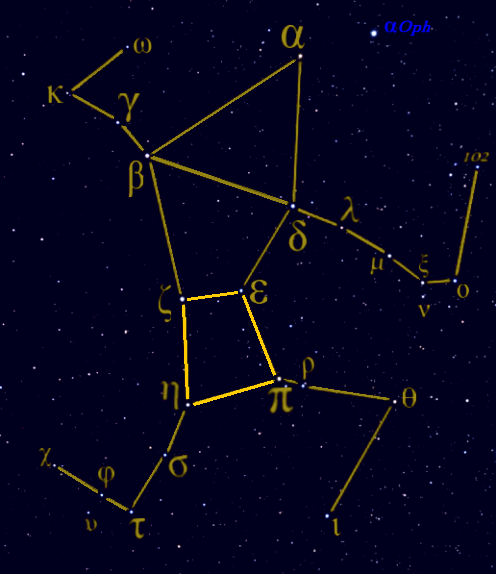Tonight, try locating one of the coolest constellations up there. The constellation Hercules the Kneeling Giant can be seen ascending in the east-northeast on these Northern Hemisphere spring evenings. You can find Hercules in between two brilliant stars: Arcturus and Vega. The chart at the top of this post shows the sky for around 9 to 10 p.m. local time (10 to 11 p.m. Daylight Time), when the constellation Hercules, and the two stars so essential for finding it, are well up in the northeastern to eastern sky.
Arcturus is in the constellation Bootes, and Vega is in the constellation Lyra.
At nightfall, Vega may still be below in your horizon. If so, wait awhile … it’ll rise soon.
A line between Arcturus and Vega passes through what is known as the Keystone – an asterism, or noticeable pattern – in Hercules. The Keystone is a squarish figure in the center of Hercules. See it on the charts above and below?
Enjoying EarthSky so far? Sign up for our free daily newsletter today!

The constellation Hercules, with its prominent Keystone asterism marked. Image via Wikimedia Commons.
The Keystone is a helpful pattern for more reasons than one. First, it’s noticeable on the sky’s dome, so it can lead your eye to Hercules.
Also, the Keystone in Hercules can help you find the most fascinating telescopic object within the boundaries of this constellation. This object is a globular star cluster known to stargazers as M13 or the Great Cluster in Hercules. M13 barely visible the eye alone in the darkest of skies, but binoculars show it as a nebulous starlike patch of light. And telescopes show stars both on the periphery of the cluster and toward its center.
This beautiful object is one of the galaxy’s oldest inhabitants. It’s a tightly packed spherical collection of about one million stars.
Read more: M13 or the Great Cluster in Hercules
EarthSky astronomy kits are perfect for beginners. Order today from the EarthSky store
M13, aka the Great Cluster in Hercules. This object is a globular star cluster, one of our galaxy’s oldest inhabitants. More about M13: Great cluster in Hercules Photo via Bareket Observatory in Israel, via CelestronImages.
Bottom line: Use the brilliant stars Arcturus and Vega to find the constellation Hercules tonight!
Donate: Your support means the world to us
from EarthSky https://ift.tt/1rdci4D
Tonight, try locating one of the coolest constellations up there. The constellation Hercules the Kneeling Giant can be seen ascending in the east-northeast on these Northern Hemisphere spring evenings. You can find Hercules in between two brilliant stars: Arcturus and Vega. The chart at the top of this post shows the sky for around 9 to 10 p.m. local time (10 to 11 p.m. Daylight Time), when the constellation Hercules, and the two stars so essential for finding it, are well up in the northeastern to eastern sky.
Arcturus is in the constellation Bootes, and Vega is in the constellation Lyra.
At nightfall, Vega may still be below in your horizon. If so, wait awhile … it’ll rise soon.
A line between Arcturus and Vega passes through what is known as the Keystone – an asterism, or noticeable pattern – in Hercules. The Keystone is a squarish figure in the center of Hercules. See it on the charts above and below?
Enjoying EarthSky so far? Sign up for our free daily newsletter today!

The constellation Hercules, with its prominent Keystone asterism marked. Image via Wikimedia Commons.
The Keystone is a helpful pattern for more reasons than one. First, it’s noticeable on the sky’s dome, so it can lead your eye to Hercules.
Also, the Keystone in Hercules can help you find the most fascinating telescopic object within the boundaries of this constellation. This object is a globular star cluster known to stargazers as M13 or the Great Cluster in Hercules. M13 barely visible the eye alone in the darkest of skies, but binoculars show it as a nebulous starlike patch of light. And telescopes show stars both on the periphery of the cluster and toward its center.
This beautiful object is one of the galaxy’s oldest inhabitants. It’s a tightly packed spherical collection of about one million stars.
Read more: M13 or the Great Cluster in Hercules
EarthSky astronomy kits are perfect for beginners. Order today from the EarthSky store
M13, aka the Great Cluster in Hercules. This object is a globular star cluster, one of our galaxy’s oldest inhabitants. More about M13: Great cluster in Hercules Photo via Bareket Observatory in Israel, via CelestronImages.
Bottom line: Use the brilliant stars Arcturus and Vega to find the constellation Hercules tonight!
Donate: Your support means the world to us
from EarthSky https://ift.tt/1rdci4D

Aucun commentaire:
Enregistrer un commentaire